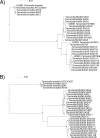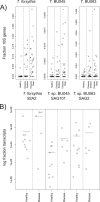Genomics of the Uncultivated, Periodontitis-Associated Bacterium Tannerella sp. BU045 (Oral Taxon 808)
- PMID: 29896567
- PMCID: PMC5989130
- DOI: 10.1128/mSystems.00018-18
Genomics of the Uncultivated, Periodontitis-Associated Bacterium Tannerella sp. BU045 (Oral Taxon 808)
Abstract
Despite decades of research into the human oral microbiome, many species remain uncultivated. The technique of single-cell whole-genome amplification and sequencing provides a means of deriving genome sequences for species that can be informative on biological function and suggest pathways to cultivation. Tannerella forsythia has long been known to be highly associated with chronic periodontitis and to cause periodontitis-like symptoms in experimental animals, and Tannerella sp. BU045 (human oral taxon 808) is an uncultivated relative of this organism. In this work, we extend our previous sequencing of the Tannerella sp. BU063 (human oral taxon 286) genome by sequencing amplified genomes from 11 cells of Tannerella sp. BU045, including 3 genomes that are at least 90% complete. Tannerella sp. BU045 is more closely related to Tannerella sp. BU063 than to T. forsythia by gene content and average nucleotide identity. However, two independent data sets of association with periodontitis, one based on 16S rRNA gene abundance and the other based on gene expression in a metatranscriptomic data set, show that Tannerella sp. BU045 is more highly associated with disease than Tannerella sp. BU063. Comparative genomics shows genes and functions that are shared or unique to the different species, which may direct further research of the pathogenesis of chronic periodontitis. IMPORTANCE Periodontitis (gum disease) affects 47% of adults over 30 in the United States (P. I. Eke, B. A. Dye, L. Wei, G. O. Thornton-Evans, R. J. Genco, et al., J Dent Res 91:914-920, 2012), and it cost between $39 and $396 billion worldwide in 2015 (A. J. Righolt, M. Jevdjevic, W. Marcenes, and S. Listl, J Dent Res, 17 January 2018, https://doi.org/10.1177/0022034517750572). Many bacteria associated with the disease are known only by the DNA sequence of their 16S rRNA gene. In this publication, amplification and sequencing of DNA from single bacterial cells are used to obtain nearly complete genomes of Tannerella sp. BU045, a species of bacteria that is more prevalent in patients with periodontitis than in healthy patients. Comparing the complete genome of this bacterium to genomes of related bacterial species will help to better understand periodontitis and may help to grow this organism in pure culture, which would allow a better understanding of its role in the mouth.
Keywords: Tannerella; WGA; oral microbiology; periodontitis; single cell.
Figures




Similar articles
-
Comparative genome characterization of the periodontal pathogen Tannerella forsythia.BMC Genomics. 2020 Feb 11;21(1):150. doi: 10.1186/s12864-020-6535-y. BMC Genomics. 2020. PMID: 32046654 Free PMC article.
-
Uncultivated Tannerella BU045 and BU063 are slim segmented filamentous rods of high prevalence but low abundance in inflammatory disease-associated dental plaques.Microbiology (Reading). 2007 Nov;153(Pt 11):3809-3816. doi: 10.1099/mic.0.2007/010926-0. Microbiology (Reading). 2007. PMID: 17975090
-
Single cell genomics of uncultured, health-associated Tannerella BU063 (Oral Taxon 286) and comparison to the closely related pathogen Tannerella forsythia.PLoS One. 2014 Feb 14;9(2):e89398. doi: 10.1371/journal.pone.0089398. eCollection 2014. PLoS One. 2014. PMID: 24551246 Free PMC article.
-
Nonulosonic acids contribute to the pathogenicity of the oral bacterium Tannerella forsythia.Interface Focus. 2019 Apr 6;9(2):20180064. doi: 10.1098/rsfs.2018.0064. Epub 2019 Feb 15. Interface Focus. 2019. PMID: 30842870 Free PMC article. Review.
-
Peptidoglycan synthesis in Tannerella forsythia: Scavenging is the modus operandi.Mol Oral Microbiol. 2018 Apr;33(2):125-132. doi: 10.1111/omi.12210. Epub 2018 Feb 12. Mol Oral Microbiol. 2018. PMID: 29247483 Free PMC article. Review.
Cited by
-
Multispecies biofilm behavior and host interaction support the association of Tannerella serpentiformis with periodontal health.Mol Oral Microbiol. 2023 Apr;38(2):115-133. doi: 10.1111/omi.12385. Epub 2022 Aug 29. Mol Oral Microbiol. 2023. PMID: 35964247 Free PMC article.
-
Subgingival Microbiome and Specialized Pro-Resolving Lipid Mediator Pathway Profiles Are Correlated in Periodontal Inflammation.Front Immunol. 2021 Jun 10;12:691216. doi: 10.3389/fimmu.2021.691216. eCollection 2021. Front Immunol. 2021. PMID: 34177951 Free PMC article.
-
Standardized studies of the oral microbiome: From technology-driven to hypothesis-driven.Imeta. 2022 Apr 11;1(2):e19. doi: 10.1002/imt2.19. eCollection 2022 Jun. Imeta. 2022. PMID: 38868569 Free PMC article. Review.
-
Deciphering fucosylated protein-linked O-glycans in oral Tannerella serpentiformis: Insights from NMR spectroscopy and glycoproteomics.Glycobiology. 2024 Dec 10;34(12):cwae072. doi: 10.1093/glycob/cwae072. Glycobiology. 2024. PMID: 39298555 Free PMC article.
-
Comparative genome characterization of the periodontal pathogen Tannerella forsythia.BMC Genomics. 2020 Feb 11;21(1):150. doi: 10.1186/s12864-020-6535-y. BMC Genomics. 2020. PMID: 32046654 Free PMC article.
References
Grants and funding
LinkOut - more resources
Full Text Sources
Other Literature Sources
Molecular Biology Databases

